8 Types of Radishes That Add Beautiful Color and Peppery Flavor to Salads (and More)
We spoke to culinary experts to learn about different types of radishes and their favorite uses for each.
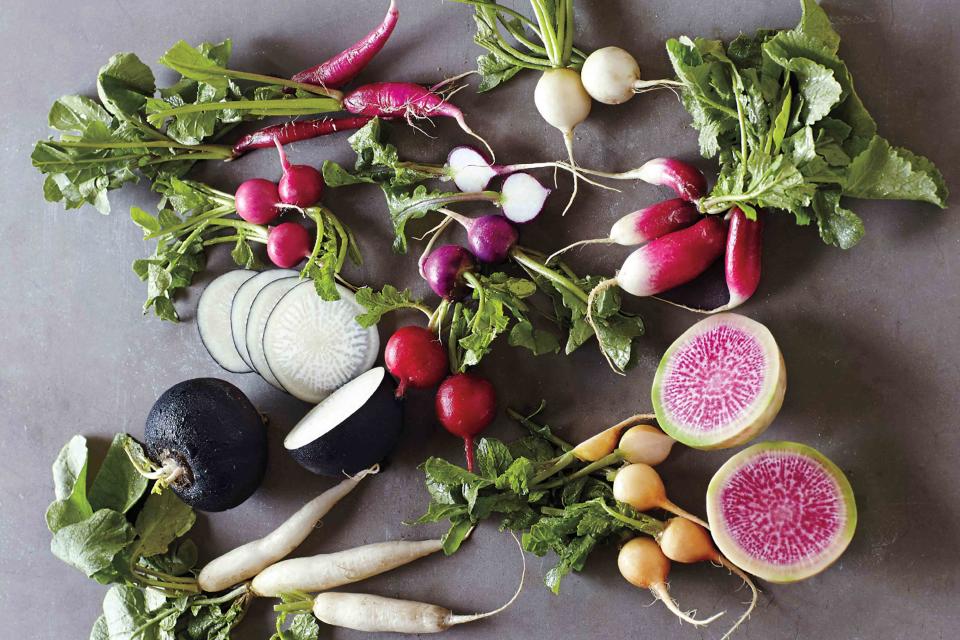
Linda Pugliese
Few members of the vegetable family are as classic as a round red radish with its snowy interior and satisfying crunch. But wait a minute; are all radishes bright red? What about that tie-dye-esque watermelon radish on your salad at that fancy restaurant the other night? And what about that deep purple radish you picked up at the farmer’s market? As it turns out, the world of radishes is one filled with an array of shapes, colors, and flavors. Ahead, we spoke to experts for a run-down on how to use radishes and their favorite types of radishes that you, too, can add to your culinary arsenal.
Meet Our Expert
Matt Hiltner, marketing manager of Babé Farms in Santa Maria, California
Ann Ziata, chef at the Institute of Culinary Education’s New York City campus
Natalie Munoz, marketing specialist of Little Bear Produce in Edinburg, Texas
Radishes Defined—and Culinary Uses
Radishes are root vegetables that are part of the mustard or cabbage family, Brassicaceae (try to say that five times fast!).
“The beauty of radishes is the wide spectrum of colors, shapes, and sizes they exhibit,” says Matt Hiltner, marketing manager of Babé Farms in Santa Maria, CA. It’s worth noting that different cultures may picture different things when radishes are mentioned. “For example, here in the U.S., most of us generally picture small, round, red radishes with leafy greens attached, while in certain Asian countries, they are more used to the long, white, cylindrical daikon variety that can sometimes get up to two feet in length,” says Hiltner, who believes that with such a broad cultural reach, the applications are seemingly endless for this popular root vegetable.
Hiltner, along with Ann Ziata, chef at the Institute of Culinary Education’s New York City campus, tick off a few notes on the culinary uses of radishes:
Radishes can be enjoyed raw, pickled, sautéed, braised or roasted.
You can also add radishes to soups and stews.
Raw applications have stepped into the spotlight in the restaurant world, with sliced radishes garnishing salads, tacos, pizzas/flatbread, sushi, and more, says Hiltner.
Colorful, raw radishes are a popular addition to all types of charcuterie boards and crudités plates.
When you pickle radishes, it mellows out their bite, so this might be a good preparation for people who don’t like the spicy notes of radishes.
Using raw radishes with some whipped butter and sea salt on a French baguette is one of the most classic and easiest ways to prepare radishes.
And here’s a fun fact: You can eat the greens that come with radishes, which have a similar peppery taste with a mild bitterness, says Hiltner.
Types of Radishes
These root vegetables generally have a pungent, peppery, and slightly sweet taste. “Beauty with a great personality: it’s easy to see why the radish has found its way into so many chefs’ hearts,” says Ziata. And what about that kick? As Hiltner says, the spice level of radishes ranges from mild to medium and depends on the variety—some of which are listed below.
Red Radishes
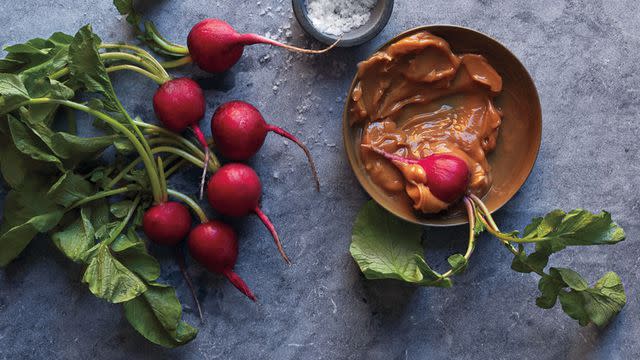
Most radishes sold in grocery stores are round red varieties. Red radishes are sold in bunches of about ten, the most popular being scarlet globe. You may have also heard of Cherry Belles, a type of radish that is an heirloom variety, much like the scarlet globe. Natalie Munoz, marketing specialist of Little Bear Produce in Edinburg, Texas, likes that these ruby or red radishes offer an earthy, spicy, and peppery flavor profile while being crunchy and crisp. Munoz and Ziata share their top ways to enjoy red radishes below:
Serve red radishes as a snack or in salads.
Slice red radishes thinly as a crunchy sandwich topping.
Use red radishes as a garnish for an elegant plating and added textural element to a dish.
Roast in bite-sized halves or quarters for a refreshing and slightly sweet side or snack.
Serve red radishes as a side dish solo or in a medley with spring vegetables.
Red radishes are extremely versatile and can be sliced into a quick pickle to garnish raw fish, grilled proteins, barbecued meats, tacos, and fried chicken.
French Breakfast Radish

Martha Stewart
Ziata describes French breakfast radishes as small, long, and skinny, with a pretty hot pink color that fades to white at the tips. “Their shape is so naturally delightful that you can cook them whole or cut in halves lengthwise,” says Ziata. “They have a milder flavor, similar to a red radish, so you don’t have to do much to them.”
Sauté French breakfast radishes in butter with fresh herbs and salt.
Serve French breakfast radishes with crusty French bread and butter or bagna cauda.
Serve sautéed French breakfast radishes atop the egg dish of your choice, like Martha’s scrambled eggs or roasted cherry tomato clafoutis.
Watermelon Radish
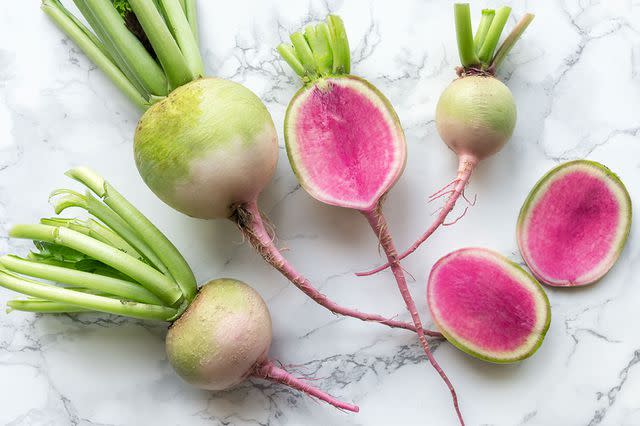
Eugene03 / Getty Images
This multi-hued radish lends a fanciful touch to any dish it graces. As Ziata says, watermelon radishes are usually the size of an apple, with a greenish-white skin and a bright fuchsia center. They also don’t have any relation to the fruit; watermelon radishes get their name from their "strikingly attractive watermelon-pink interior,” she says. Be sure to peel them, as the skin is quite rough. These radishes provide more sweetness than globe radishes.
Enjoy watermelon radishes raw in thick wedges on your crudité platter, served with dip.
Cut into matchsticks, watermelon radishes are wonderful in a slaw or salad.
Make bright and crunchy salmon with frizzled shallots and watermelon radish.
Daikon Radish
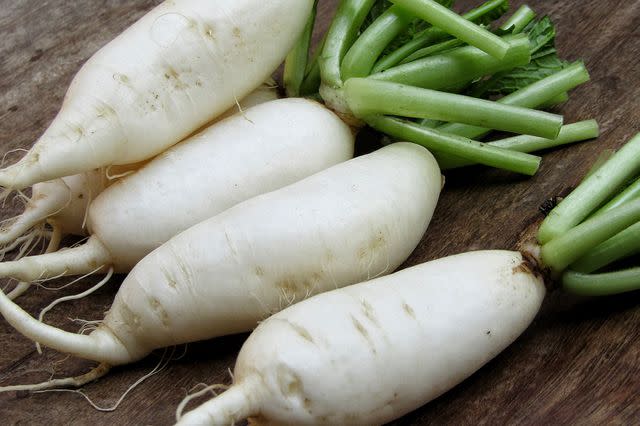
Sadasiba Behera / Getty Images
Daikon radishes are elongated bulbs featuring a white exterior and a crisp, white interior. “Daikon radishes are ghostly white and grow as a wide, elongated root. Imagine a large, thick carrot,” says Ziata. If you’re thinking of noshing on daikon radish by itself as a snack, take note that cooking daikon radish will mellow its intensity, so you might find it more palatable in its cooked form. “Daikon has a concentrated, pungent flavor and if enjoyed raw, it’s usually a small amount,” says Ziata. Munoz and Ziata share the following ideas for using daikon radishes in your culinary repertoire:
Slice daikon radishes thinly and add them to salads, stir-fries, or soups.
Pickle daikon radish to use as a garnish or condiment.
Shaved daikon is traditionally served with sushi, as it is believed to aid digestion.
Simmer daikon radish in a dashi stock with a little soy sauce to bring out its sweetness.
Black Spanish Radish
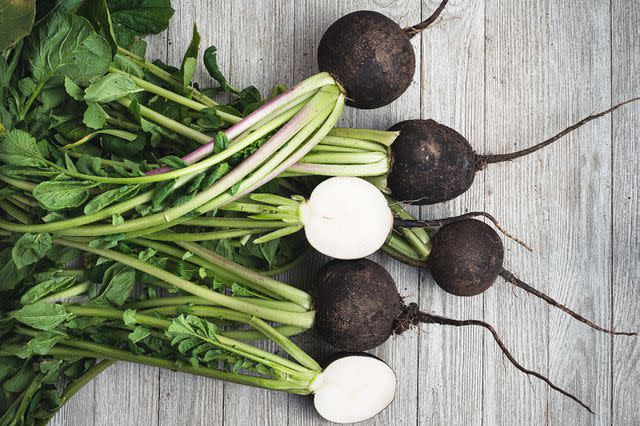
nadiasphoto / Getty Images
Black Spanish radishes have a white center with matte black skin, says Ziata, highlighting that some black Spanish radishes are round and others grow long. “They have a very pungent flavor and pair well with other bold flavors,” she adds. To try these stunning radishes, consider these ideas:
Pair black Spanish radishes with any dish that has potent flavors, such as truffle, garlic, or lemongrass.
To take some of the edge off, slice black Spanish radishes thin and bake them into chips.
Roast black Spanish radishes with miso paste for an easy side dish.
Easter Egg Radishes
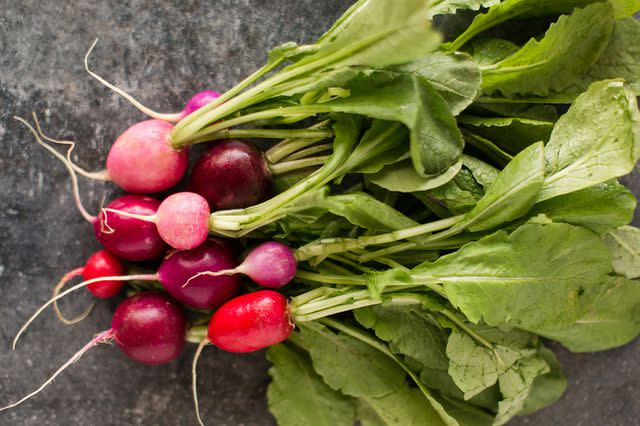
Crystal Bolin Photography / Getty Images
A darling name for a delightful radish. Easter egg radishes are a "vibrant, bunched medley of round radishes,” says Hiltner, that include any of the following: red (Cherrie Belle), pink (Rosa), purple (Plum), and white (Sno Ball). “While these assorted radishes vary in color, they all possess a fairly consistent mild spice level and crisp, white flesh under their thin skin,” says Hiltner.
Use these radishes for decorating salads.
Add Easter egg radishes as a colorful addition to roasted root vegetable dishes—particularly on Easter and Mother's Day menus.
Add Easter egg radishes to grazing plates to snack on before a meal.
Purple Plum Radish
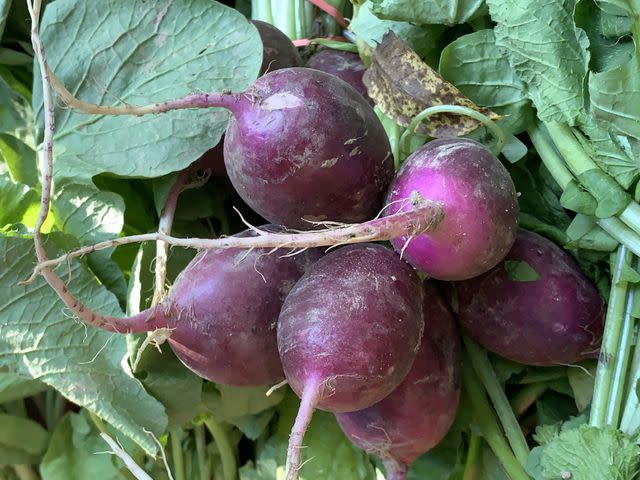
Photography by Keith Getter (all rights reserved) / Getty
The purple plum radish is similar to many red radishes and other varieties of the Easter egg category, save for a “beautiful deep violet skin,” says Hiltner. Like Easter egg radishes, the inner flesh is white, the exterior skin is quite thin, and it has a mild spice level for the palate. Hiltner’s go-to uses of purple plum radishes include:
Top crostini with thinly sliced into coins and arrange over a spread of whipped butter, cream cheese, or hummus.
Create a subtle pop of color for charcuterie boards.
Incorporate purple plum radishes into appetizers.
White Icicle Radish
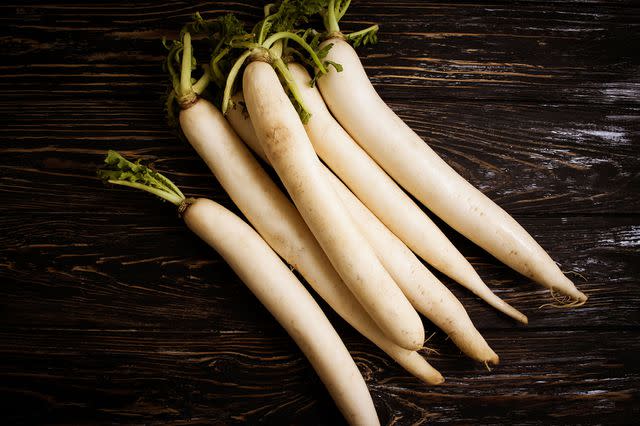
Getty Images
Another aptly named radish, this elongated radish has a white exterior and flesh. Each radish measures about three to four inches in length, so if you don’t cut them, it might take you multiple bites to make it through a white icicle! Describing them as “crisp and juicy with medium spice level,” here’s how Hiltner recommends using them:
The white icicle radish can be shaved lengthwise, creating decadent ribbons to garnish a salad.
Use the above garnishes to top off any entrée for an elegant presentation.
White icicle’s length also makes it a superb option for crudités plates in which it is paired with a creamy dip, dressing, or hummus.
Read the original article on Martha Stewart.

